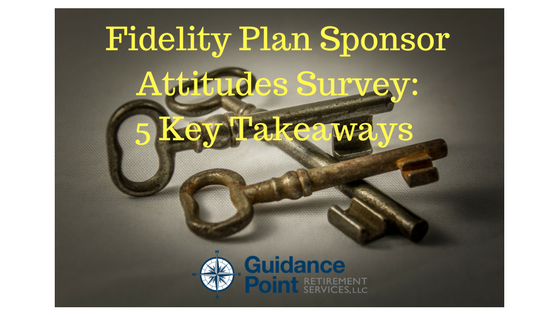
Our research team recently met with our dedicated Defined Contribution Investment Only (DCIO) Fidelity Institutional Asset Management representative, Mike Manosh. Mike shared and discussed with our team the Fidelity Plan Sponsor Attitudes Survey. We thought that the conversation was productive and wanted to share the survey with you, a Retirement Plan Sponsor, and our Five Key Takeaways from the 2017 edition.
-
Retirement Plan Sponsors are changing how they work with their Retirement Plan Advisor. The top reasons for hiring a Plan Advisor are:
- concerns about their fiduciary responsibilities
- increasing retirement plan complexity due to company growth
- investment selection and monitoring
This is in line with our experience at Guidance Point, many plan sponsors have started to raise their expectations of their Plan Advisor and no longer only want help on investments. Clients are coming to us as they experience this disconnect from their current plan advisor. Fiduciary concerns are at an all-time high as the lead answer for reasons why a Plan Sponsor is hiring a Plan Advisor.
- Only 65% of retirement plan sponsors overall are very or highly confident in their understanding of their fiduciary responsibilities. Plan sponsors continue to struggle with their understanding of ERISA and whether they are in compliance with Department of Labor and IRS standards. This continues to be an issue for retirement plan committees as new members rotate on and off the committee, and plan complexity increases. This finding is unchanged from 2016 to 2017.
- Ninety-two percent of plan sponsors have made a plan design change in the past two years with auto-enrollment being the most prevalent change in plan documents. Increasing default deferral rates, changing matching contribution, and auto escalation of deferrals are also popular plan design changes being adopted. Our consultants continue to see and lobby to our Plan Sponsor clients these changes, where appropriate, to help participants improve retirement outcomes.
- Plan Sponsors may not have a sound methodology when selecting their Qualified Default Investment Alternative (QDIA). 53% of plan sponsors chose performance as the reason why their QDIA was chosen. Our research team believes that finding the default fund, such as a Target Date Fund, that best matches your plan’s participant behaviors, retirement readiness and risk attitudes is a better methodology for selecting a QDIA. Read more about our Target Date Fund (TDF) selection methodology.

- Ninety-three percent of plans have made an investment menu change in the last two years. 43% of plans surveyed changed their TDF (back to point #4). A Target Date Fund change can increase a plan sponsor’s liability since participants are generally defaulted into the investment, and 50 cents of every $1.00 of participant contributions go into these funds. Plan Sponsors should be sure to evaluate the change of the glide path when performing mapping of their old TDF to the new TDF. For example, TDF A’s 2025 fund may have an equity allocation of 50% when TDF B’s 2025 could have 70% equity allocation. An inadvertent increase in risk of a participants’ retirement account may lead to increased liability for plan sponsors and plan advisors if a bear equity market were to soon occur.

If you’d like to download the survey, it is available to you as a Retirement Plan Sponsor. You can download this from the following link:
https://institutional.fidelity.com/app/item/RD_13569_26306/plan-sponsor-attitudes.html
Other blogs to consider:
